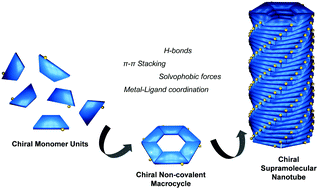Chiral nanotubes self-assembled from discrete non-covalent macrocycles
Abstract
Many strategies have been used to construct supramolecular hollow tubes, including helical folding of oligomers, bundling of rod-like structures, rolling-up of sheets and stacking of covalent cycles. On the other hand, controlling chirality at the supramolecular level continues attracting much interest because of its implications in future applications of porous systems. This review article covers the main examples in the literature that use simple molecular structures as chiral units for precise assembly into discrete non-covalent cyclic structures that are able to form chiral supramolecular tubular systems.

- This article is part of the themed collection: 2021 Emerging Investigators


 Please wait while we load your content...
Please wait while we load your content...